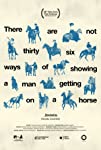Eye For Film >> Movies >> There Are Not Thirty-Six Ways Of Showing A Man Getting On A Horse (2020) Film Review
There Are Not Thirty-Six Ways Of Showing A Man Getting On A Horse
Reviewed by: Anne-Katrin Titze

Nicolás Zukerfeld’s There Are Not Thirty-Six Ways Of Showing A Man Getting On A Horse (No Existen Treinta Y Seis Maneras De Mostrar Cómo Un Hombre Se Sube A Un Caballo), his tribute to Raoul Walsh, co-written and expertly edited with Malena Solarz, is a highlight of the Currents program in the 58th New York Film Festival (screening virtually for five days with Guy Maddin, Evan Johnson, and Galen Johnson’s mysterious fairground short, Stump The Guesser, starting this Friday).
The 1924 Douglas Fairbanks adventure The Thief of Bagdad; the 1933 musical Going Hollywood with Bing Crosby; Rita Hayworth and Olivia de Havilland and James Cagney in the 1890s stage world of Strawberry Blonde (1941); the 1958 Norman Mailer adaptation The Naked And The Dead; the 1960s Biblical drama Esther And The King, with Joan Collins in the title role - it isn’t easy to pick only one Raoul Walsh film for each decade out of the many excerpted in Zukerfeld’s uncategorisable whirlwind inquiry into the Hollywood master’s work. Westerns and the crime genres loom large.
Chapter One is entirely made up of clips chosen from Walsh’s 140 films, which are neither commented on, nor identified, but rhythmically and thematically arranged into a feast for eyes and the brain. We start with men getting on horses. More than 36 of them. Many of them the same way, from the left, of course. One jumps up from the back. Is it shown the same way? You’ll be the judge. There are John Wayne and Kirk Douglas and Clark Gable. Douglas looks at the desert. Robert Mitchum at Native Americans. One guy falls off the horse and tries mounting again. Horses without saddle, lots of them, a style is developing.
Errol Flynn and Anthony Quinn as a Native American. Just as you begin to wonder, no women? There is Jane Russell shooting a gun. More Flynn, more and more horses are crossing a river. There is a bazaar, movie magic lets borders disappear. Is this Paulette Goddard? Here is Ann Blyth in startling technicolor and Virginia Mayo scowling. Sometimes the clips are gone so fast, you can’t be sure if this was Teresa Wright walking by. In any case, the dresses they wear are smashing and the women have to be tough in these very male worlds of saloons and prairie.
Rock Hudson introduces that the horses need to rest for a while. Joel McCrea sees a cowboy hat on the ground, Clark Gable sees someone shot. Battle, cattle, thunderstorm. How does Walsh show them? Mitchum walks to the ruins of a hut and Sidney Poitier sings (in a dubbed voice) “to blow the man down”. Gable watches shutters crashing in the wind, Cagney is concerned, water is coming, Bing Crosby sees it. What is it? “How is he?” asks Humphrey Bogart. Mitchum is followed by the melody of The Streets Of Laredo. Gregory Peck visits a sick woman, so does Mae West. People come through doors - take note, this will be important for Chapter Two!
Someone brings letters to a convent, to Henry Fonda, and to Errol Flynn, while he is having a new jacket tailored. Next come the awakenings; Fairbanks sees a sleepy lady, Crosby doesn’t know what year it is (1934!), Marlene Dietrich is searching for a slipper under her bed. “Good Morning” say Bogie and Edward G Robinson and ZaZa Gabor. Yes, Hollywood showed us how to start the day. Tea? Coffee? Leggy ladies, little babies, Louis Armstrong, then Jack Benny carrying a trumpet, three monkeys in costume, behind endless doors opening and closing.
Suspense lives in the dark, Cary Grant shuts off the light. Where is the soldier who spoke English, asks a Nazi in German. Gloria Swanson lands behind bars. Shots, cats and even bigger cats, camels, Alexis Smith and her Gentleman Jim. And more doors, the same doors repeatedly, the visuals get faster until Bogart and the reflection in a phone booth door chime in the end of the first part of the film.
Chapter Two, a complete departure in style, has no clips, a voice-over, a mostly black screen, some notes, book covers, articles. We hear of a professor, late to his second class on Classical Film Grammar. He finds in his notes a little annotation that in D. W. Griffith’s The Birth of a Nation (1915), Raoul Walsh played John Wilkes Booth, who assassinated President Abraham Lincoln. Next, he quotes the title of Nicolás Zukerfeld’s film to his class as something Walsh had expressed in an interview. But he “mistrusts his memory.” What follows is the entertaining and stubborn search of a scholar to get to the roots of the quote, a journey that includes issues of translation for idiomatic expressions in French, nightly e-mails to and from friends and colleagues, limited archives scanned, screenshots, one and five ways to enter a room and a surprising lack of horses.
Chapter Three, the coda, drops the professor off at his third class - on comedy - and puts us musically “in the mood for love”.
Reviewed on: 21 Sep 2020
















